Influencer marketing enables brands to connect authentically with potential customers like never before. However, there are misconceptions about what works and what doesn’t, and many small and medium-sized brands feel like they’re stumbling in the dark with Instagram influencer marketing.
If you’re struggling to market your product effectively, we’re here to help. No more speculation.
This report analyzes over 17,000 influencer marketing campaigns to bring you clear, data-backed answers to questions like:
- What types of influencers drive the highest engagement?
- Are gifted campaigns actually more effective than paid ones?
- Does niche alignment really improve campaign results?
- What kind of content performs best: Reels, carousels, or single images?
- How does product placement impact audience engagement?
The information and analysis in this report aim to help brands understand influencer performance, campaign strategies, and audience targeting.
Key Findings:
- Micro-influencers (10K-50K followers) outperform mid-tier influencers (50K-100K followers) by 46%, delivering a 1.81% engagement rate compared to 1.24%.
- Nano-influencers (1K-10K followers) generate 49.7% higher engagement than micro-influencers.
- Gifted collaborations deliver 12.9% more engagement than paid partnerships, with a 2.19% engagement rate versus 1.94%.
- Niche alignment boosts performance significantly, with campaigns matching influencer niche to products seeing 13.59% higher engagement and 81.39% more views.
1. Influencer Engagement: Nano and Micro-Influencers Lead the Way
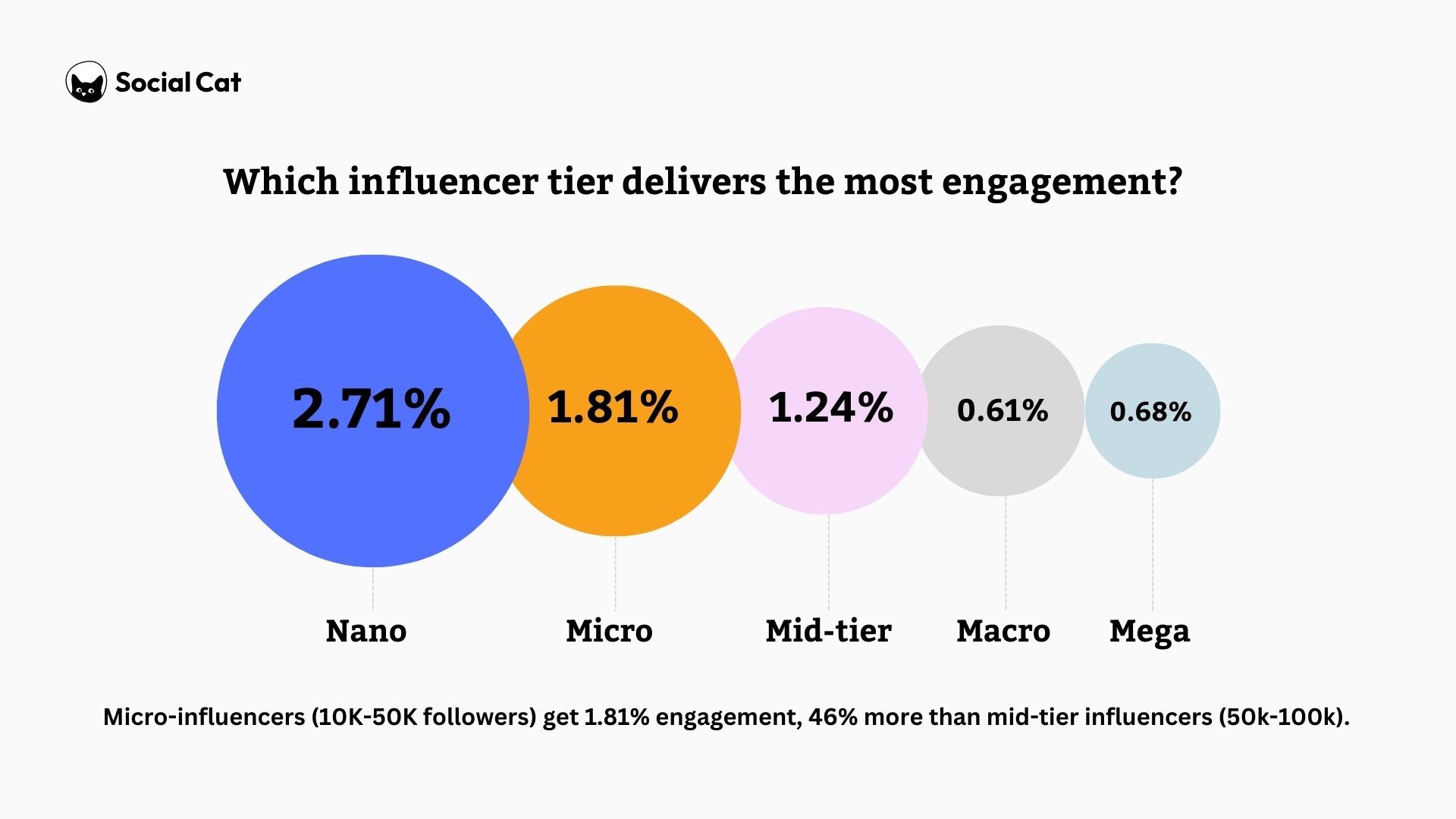
The data reveals smaller influencers often deliver the highest engagement rates.
- Nano-influencers (1K-10K followers) show the highest average engagement rate at 2.71%, followed by micro-influencers (10K-50K followers) at 1.81%.
- The difference in engagement between micro-influencers and mid-tier influencers (50k-100k) is +46%.
- The difference in engagement between nano-influencers and micro-influencers is +50%.
Table 1: Average Engagement Rate by Influencer Category
These engagement rates are significantly higher than the averages for macro-influencers (0.61% -0.87%) and mega-influencers (0.68%- 0.94%), based on third-party industry reports.
| Type of Influencer | Followers Category | Average Engagement Rate | Average Comments | Average Likes | Average Views |
| Nano Influencers | 0-10k | 2.71% | 21 | 111 | 1,437 |
| Micro-Influencers | 10k-50k | 1.81% | 30 | 428 | 15,312 |
| Mid-tier Influencers | 50k-100K | 1.24% | 44 | 1,310 | 13,905 |
Insights for businesses:
- Prioritize Micro-Influencers: Collaborate with nano-influencers and micro-influencers for campaigns targeting specific audiences, as they often provide higher engagement rates. Influencers with small followings are also more likely to agree to gifted campaigns–which we’ll discuss in a moment.
- Balance Reach and Engagement: While mid-tier influencers may offer broader reach, micro and nano-influencers can deliver more meaningful interactions. You need both to increase sales.
“Ditch the follower count obsession. It's not about size, it's about connection. Our data proves nano and micro-influencers are the real engagement drivers. For businesses aiming to build trust and drive meaningful interactions, they're the secret weapon for authentic interactions and budget-friendly wins,” says Stefan Afrăsinei, Founder at Social Cat.
2. Gifted vs. Paid Collaborations: Understanding the ROI
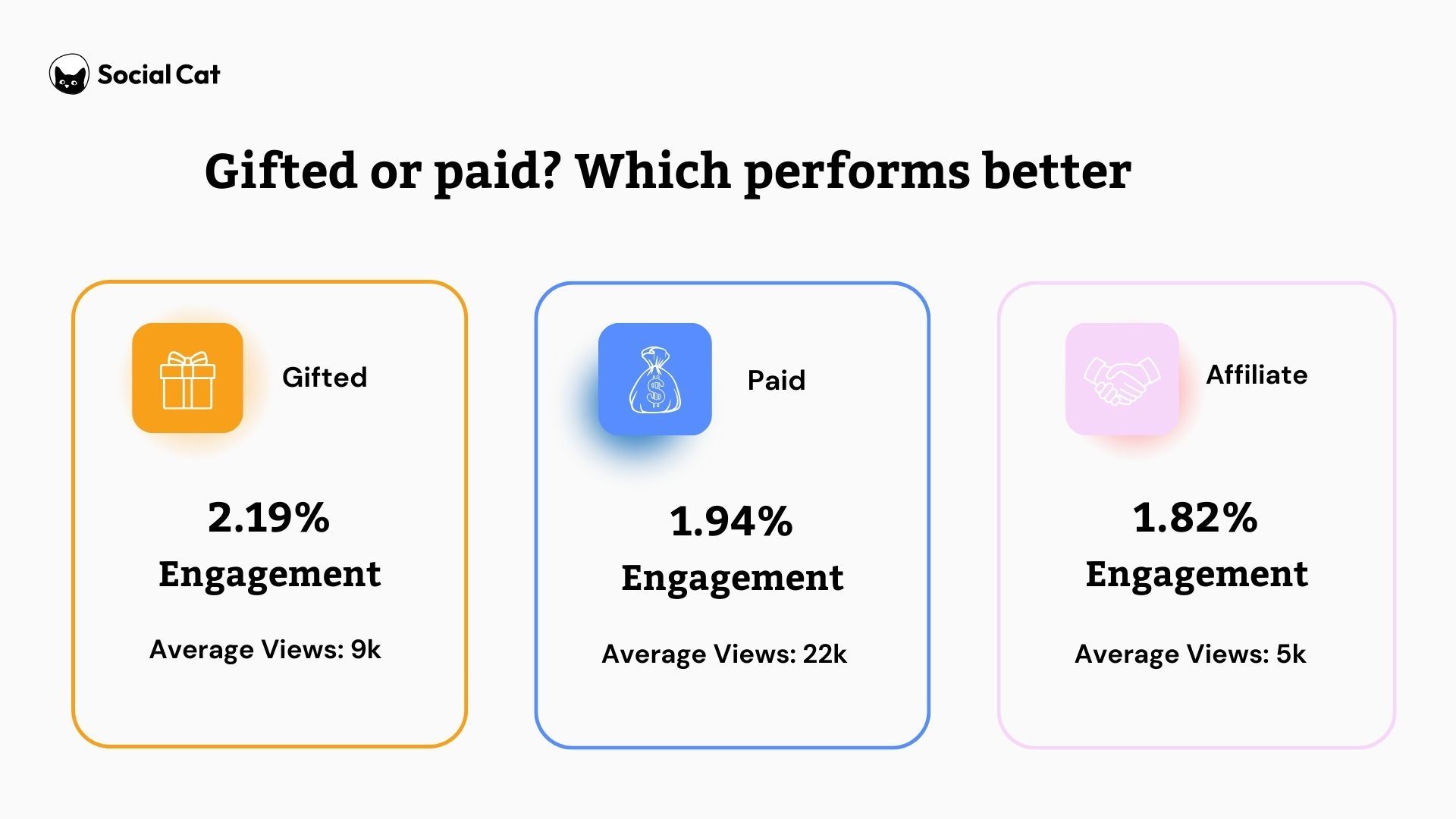
We also explored the effectiveness of gifted versus paid influencer collaborations.
- Gifted collaborations maintain a strong average engagement rate of 2.19%, higher than paid collaborations (1.94%) and affiliate collaborations (1.82%).
- Gifted collaborations see +12.9% more engagement than paid collaborations.
- The study reveals a strong preference for gifted collaborations, with 80% of brands choosing this model.
Table 2: Engagement Rate by Payment Type
| Payment Type | Avg Engagement Rate | Avg Likes | Avg Views | Avg Comments |
| Gifted | 2.19% | 361 | 9,413 | 26 |
| Paid | 1.94% | 1,392 | 22,244 | 42 |
| Affiliate | 1.82% | 412 | 4,891 | 22 |
The research also reveals a clear pattern: nano-influencers and micro-influencers respond best to gifted collaborations (2.76% engagement), while mid-tier influencers perform better with paid partnerships (1.85% vs. 1.03% for gifted).
Insights for Businesses:
- Gifted Collaborations Generate Engagement: Gifted collaborations can be a cost-effective way to achieve strong engagement, especially if you partner with nano or micro-influencers.
- Evaluate ROI: Carefully assess the return on investment for paid and gifted collaborations.
- Optimize for Engagement: Find an influencer gifting platform that allows you to filter results by engagement rate. You can fast-track your sales and marketing goals by prioritizing influencers who know how to connect with their audience.
"Forget big budgets. You’re throwing money out the window. Instead, think smart gifting. Brands are winning in the nano and micro-influencer space by gifting their products.", says Stefan Afrăsinei, Founder at Social Cat.
"This strategy is not only cost-effective, but our data shows it drives higher engagement. The key? Match your gifting approach to the influencer's audience for maximum impact. It's about strategic partnerships, not just payouts."
3. Gifted vs Paid Collaborations - Same Brand Performance
From the analysis, we identified 415 brands that have run both paid and gifted collaborations with influencers.
- The engagement rate average for gifted collaborations across the 415 brands is 2.16%, while the paid engagement average is 1.65%.
- On average, gifted collaborations have registered almost 3 times (215% more) more views than paid collaborations.
Insights for Businesses:
- Gifted Collaborations are Efficient: Gifted collaborations present a more efficient strategy for brands that maximize engagement and views per collaboration.
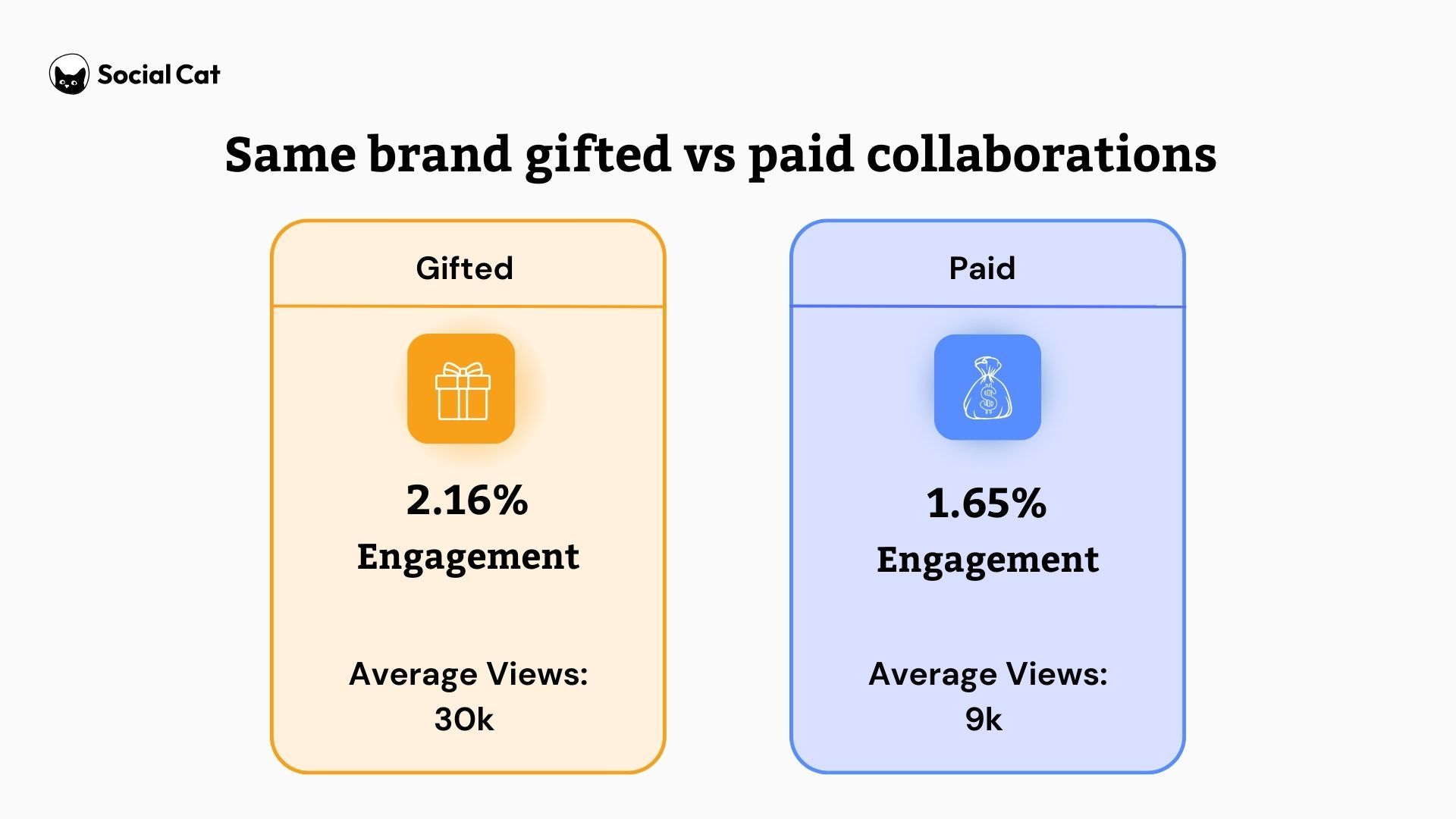
4. Niche Alignment and Engagement
Niche alignment boosts performance, with campaigns that match influencer niche to products seeing 13.59% higher engagement and 81.39% more views.
However, only 37.20% of brands chose influencers in the same niche as their product. This is a massive opportunity for improvement.
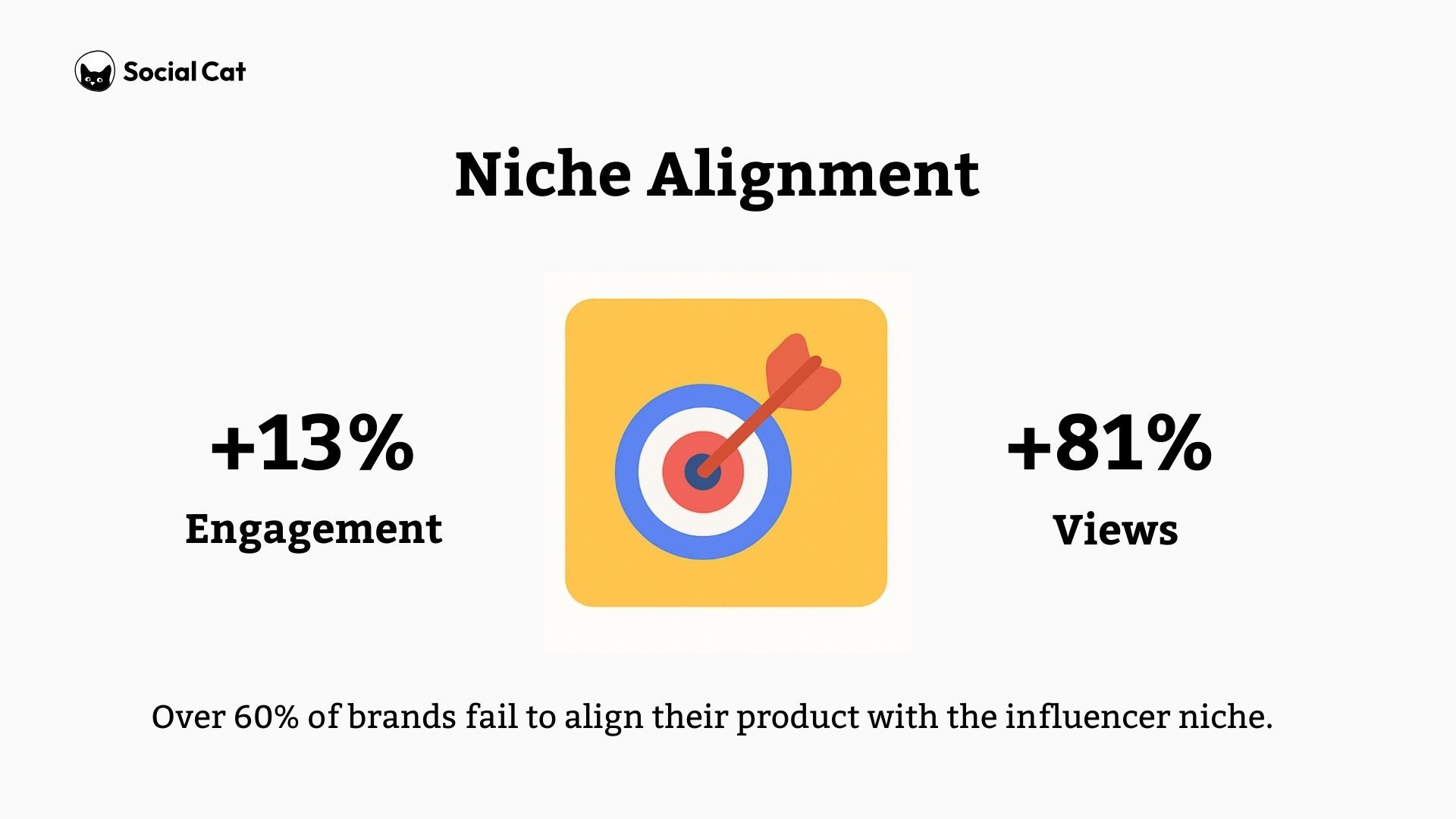
Table 4: Niche Aligned
| Niche Match | Avg Engagement Rate | Avg Views Count |
| Matched | 2.34% | 26,044 |
| Not Matched | 2.06 | 4,848 |
Insights for Businesses:
- Align with Niche Influencers: Prioritize influencers whose audience aligns closely with your brand to boost performance. This area will make a HUGE difference in your results.
- Search and Filter by Niche: One advantage of using an influencer search platform is that you can filter your results by niche. Simply type in your industry, followed by “influencers,” or search using one of the pre-existing niche filters, and you’ll get highly relevant influencers to help with your next campaign.
- Marketers sometimes even pair these platforms with data scraping tools to extract detailed influencer lists and performance metrics for faster decision-making.
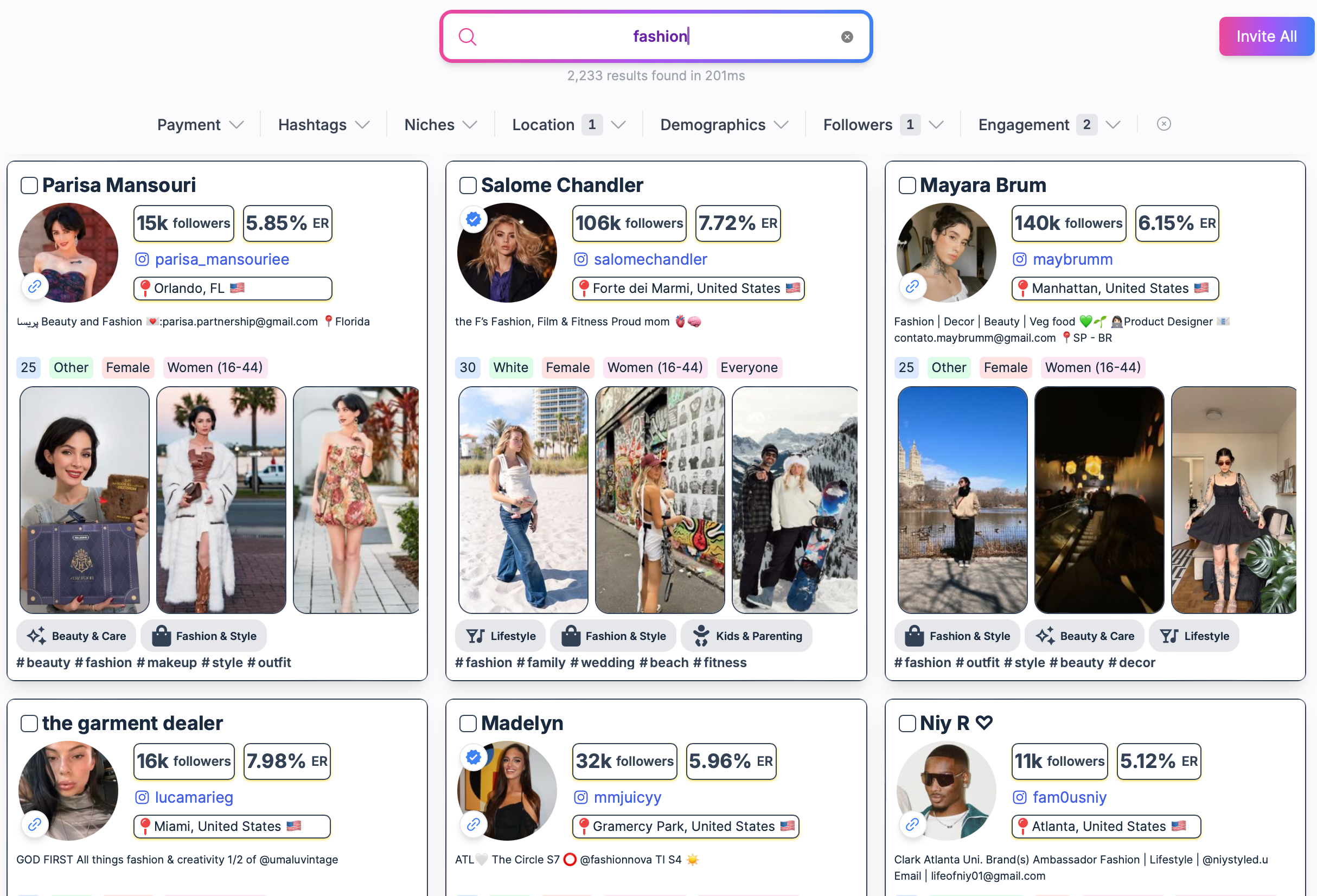
"For SMEs, it's simple: your message must resonate with potential customers, not just reach them. Partner with nano and micro-influencers who understand and love your brand. That's where you'll find real engagement," adds Stefan Afrăsinei, Founder at Social Cat. "Smart gifting is how you fuel brand awareness and sales growth."
5. Product Integration is Key
Content in which the product was seamlessly integrated into the content (also known as product placement) was 89.93% more engaging than content where the product was directly advertised.
Remember that the influencer must specify that the content is in collaboration with your brand in both cases. Even for gifted campaigns, the FTC requires the influencers to disclose any payment or freebies brands give them.
Insights for Businesses:
- Optimize Content Strategy: Focus on creating engaging content that seamlessly integrates the product.
- Minimize Obvious Sales Language: Audiences are less likely to engage when the only point of a post or video is to sell something. For example, we found that content without a direct call to action in the video had +70% better engagement than content with a clear call to action.
6. Target Audience Specification
Related to choosing the right niche–brands also need to know what audience they’re trying to reach.
- Campaigns that specified their target audience are 20.92% more engaged than those that didn’t.
- 53.62% of brands didn't list their target audience when launching a campaign.
Table 5: Engagement Rate by Target Audience Specification
| Target Audience | Avg Engagement Rate | Avg Views | Avg Likes | Avg Comments |
| With Target Audience | 2.37% | 13,999 | 533 | 30 |
| Without Target Audience | 1.96% | 7,738 | 433 | 26 |
Insights for Businesses:
- Define Your Audience: Specify your target audience when launching influencer campaigns to improve engagement and attract the right influencers.
- Choose influencers with the right audience: Check an influencer’s follower demographics before collaborating with them, and ensure your target audience is represented.
- Use audience-specific marketing strategies: Learn where your target audience hangs out online and work with influencers on those platforms. Similarly, do everything you can to appeal to and solve the problems your ideal customer faces in their life.
- Hire influencers in your target audience for UGC: If you’re looking for UGC-style content, hire influencers who are part of your target audience. That way, they’re highly relatable to potential customers. An influencer or UGC platform can help you find the right content creators.
7. Content is King: Carousel Posts Drive Engagement
The type of content shared by influencers significantly impacts audience engagement.
Carousel posts have the highest average engagement rate at 2.62%, compared to images (2.14%) and reels (2.03%).
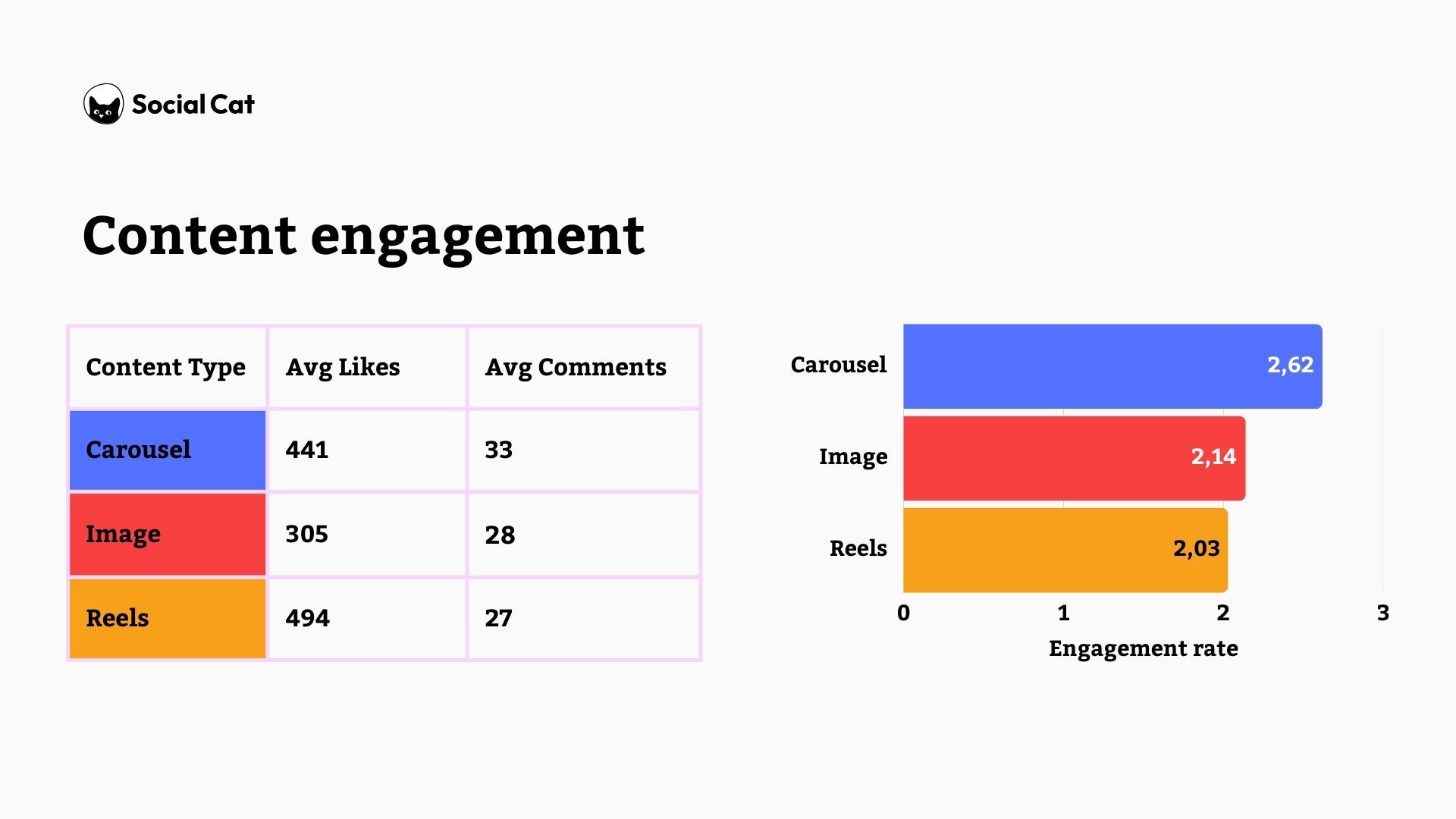
Insights for Businesses:
- Leverage Carousel Posts: Encourage influencers to utilize carousel posts, as they tend to generate higher engagement.
- Reels Drive Views but Not Engagement—Reels received higher average views (10,399) but lower engagement rates (2.03%) compared to images (2.14%) and carousels (2.62%).
8. Optimizing Content Performance: Key Learnings
Several factors influence the performance of influencer content. We analyzed 30 of the best-performing campaigns to reveal key strategies for maximizing engagement and reach:
- Content Format: Carousel posts achieve the highest engagement rates (2.62%), indicating a preference for interactive content. While Reels may not generate the same level of engagement (2.03%), they excel at driving views.
- Product Integration: Content that seamlessly integrates the product yields significantly higher engagement. Such content was 89.93% more engaging than content directly advertising the product.
- Influencer Presence: Faceless videos tend to outperform videos where the influencer is visible. Faceless videos have an average engagement rate of 46%, compared to 32% for videos with the influencer. Faceless content also received more views, averaging 6 million views compared to 1.6 million.
- Voiceovers: Content without voiceovers performs better than content with voiceovers. The average engagement for posts without voiceover was 25% higher, and the average views for posts without voiceover were 90.52% higher.
- Calls to Action: Content without a direct call to action in the video had 70% better engagement than content with a clear call to action.
To get the best results from your content, regularly experiment with different product placements and content formats to find what resonates most. Aim to make your influencer collaborations feel natural and authentic to their audience.
Data from over 17,000 influencer marketing campaigns provides valuable insights for brands hoping to enhance their influencer marketing strategy.
This study by Social Cat reveals that smaller influencers consistently outperform larger ones in key engagement metrics. By understanding the nuances of influencer engagement, influencer size, content performance, and collaboration types, SMBs can craft more effective campaigns, optimize their investments, and achieve better results.
Ready to implement these insights? Start your free trial with Social Cat today and run effective influencer campaigns with nano and micro-influencers.
Methodology:This report provides a comprehensive analysis of influencer marketing campaigns, based on a dataset of 17,715 posts across various industries and influencer types. The data is proprietary to Social Cat and reflects campaigns involving nano, micro, and mid-tier influencers. Any references to macro and mega influencers are based on third-party sources. We also analyzed 30 top-performing collaborations—measured by engagement rate, views, likes, and comments—to identify what types of content drove the most success. The goal is to deliver data-driven insights into influencer partnerships, performance and campaign strategies to help brands optimize their future influencer marketing efforts.
Table of content
- 1. Influencer Engagement: Nano and Micro-Influencers Lead the Way
- 2. Gifted vs. Paid Collaborations: Understanding the ROI
- 3. Gifted vs Paid Collaborations - Same Brand Performance
- 4. Niche Alignment and Engagement
- 5. Product Integration is Key
- 6. Target Audience Specification
- 7. Content is King: Carousel Posts Drive Engagement
- 8. Optimizing Content Performance: Key Learnings
Looking for influencers?
Table of content
- 1. Influencer Engagement: Nano and Micro-Influencers Lead the Way
- 2. Gifted vs. Paid Collaborations: Understanding the ROI
- 3. Gifted vs Paid Collaborations - Same Brand Performance
- 4. Niche Alignment and Engagement
- 5. Product Integration is Key
- 6. Target Audience Specification
- 7. Content is King: Carousel Posts Drive Engagement
- 8. Optimizing Content Performance: Key Learnings

About Stefan A.
Stefan is a Growth Marketer turned founder with a background in customer acquisition, Influencer Marketing, and early-stage startups. At Social Cat, Stefan drives day-to-day operations and growth, helping small brands connect with the right influencers to scale their reach and impact.









